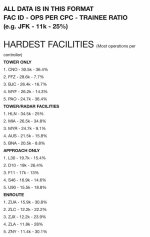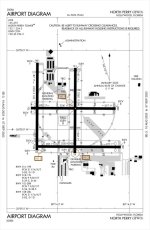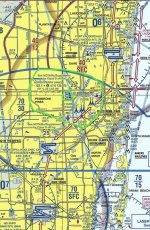GoGators It’s calculated by dividing total number of ops by total number of CPCs. It’s not a perfect formulation but it at least gives you a general idea. What you fail to realize is in 2019 (the year I worked at HWO and the year you’re referencing), HWO was ranked 28th in the country in tower ops. Little ole contract facility nobody gave a fuck about.
As to you “thinking” ground at any “higher level core 30 is
way harder than any of those low levels listed for tower” … brother I would challenge you on that 8 days of the week. Don’t take that as me advocating that ground at LAX or DAL or ATL is easy by any stretch of the imagination. Don’t attempt to speak on the situation unless you’ve stood silently in the background of the tower cab on a day where you have 2 controllers for an entire shift and you push 1,500 ops that day on a north or south operation. While I haven’t worked at a level 10, 11, 12 tower, I’d bet my bank on putting that ground operation toe to toe with any airport in the FAA of your choosing.
How many times have you plugged in, cut the ATIS, and 7 minutes into opening the tower you’re calling out on the frequency “last calling ground remain on the ramp and standby, you’re number 33”? Because I’ve done it, multiple times. North or south operation at North Perry is one of the most difficult ground operations in the NAS and I’ll fight that to the grave. I received a ground pass down one day that went something like this:
“This is XX briefing YY on ground… **points out to airfield** this is what you’ve got.” Release the brief button and first transmission is “attention all aircraft do not speak on frequency until spoken to, I see all y’all out there and I will reach out individually to get you where you’re going. If you’re conducting pattern work, expect to taxi back to the ramp for an hour plus delay for traffic work, let’s get it.” **five planes immediately key up at the same time and squelch in your ear**
We had six controllers and a manager who was at hooters more often than the tower. It’s a bitch pulling into the parking lot at 640am and seeing 15 planes lined up doing run ups at the hood short of each runway.
Before you say I’m embellishing, we’ve had your FAA counterparts visit for an investigation/study. Reps from ATLA, MSP, and MIA. Who simply stood in the back observing. To have all three reps stop you on your way out the door after a 10 hour shift and ask if you do that every single day, 5-6 hours on position at a time without a break, can’t split local off, and run at that capacity day in and day out. To then tell you if you can work that traffic on a routine basis, that you could work at any facility in the NAS? I have ground to stand on.
But don’t gaslight me or anyone who’s worked the operation because you “think” it’s more difficult elsewhere. It’s time y’all put some respect on the name.
Here’s our airfield diagram and airspace map for reference. I’ve seen planes instructed to enter left downwind for 01L, called their interval, cleared to land, emphasis on 01L and they land 10L and miss 2 planes by less than 50ft. I’ve had simultaneous departures off 10L and 10R, aircraft off 10R have engine failure departure end airborn and make a diving left turn to land 10L opposite direction and the 10L departure run off the runway at full power to avoid the crashing emergency. I’ve had banner towers lose their engine with a banner in tow, drop the banner on the street, and crash into a parking garage resulting in fatalities. I’ve had a Seneca lose power on a 3 mile final and crash into a bank parking lot killing both student and instructor. I’ve had aircraft catch fire at the hold short. On more occasions than I can count have I had aircraft on unstable approach veer off the runway. I’ve had really good pilots/instructors go down in the Everglades, break both legs, manage to survive. I once had a student conducting their
first solo, taxi out, depart without clearance, have to go around, next pass land, and run off the runway edge and crash. I was only there for a year. I’ve seen more accidents in that time than most people see in their careers.
What was the FAA’s solution? “We’re going to increase your staffing from 8 to 10.” Gee, thanks. That sure solves the issue of being able to staff the facility. Love the pat on their own back for fixing the problem. So instead of being 75% staffed we were 60%.
And to your very last point, nobody claimed anything was easier or harder. The post was simply highlighting based on one set of numbers who works the most and least ops per controller. It’s only one measurement. While the list does say “hardest facilities” it clarifies that it means most ops per controller. Ops per controller doesn’t paint the whole picture and it’s only 1 dimensional but it’s a metric nonetheless. Anyways…
**steps down off pedestal**
View attachment 8714View attachment 8715


